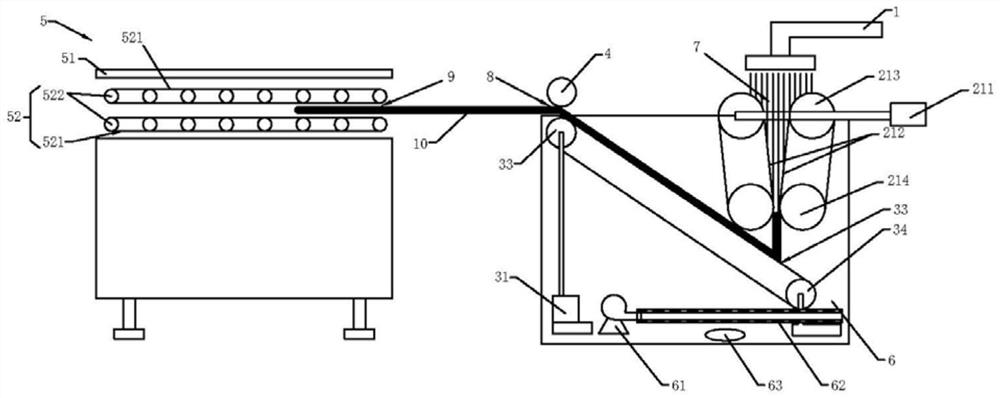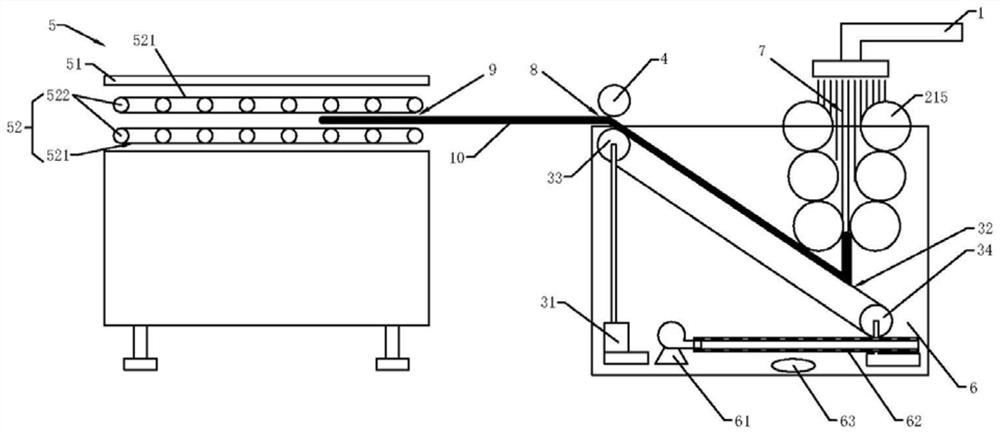A production process and equipment for a wire wrapping pad
A technology of production equipment and production process, applied in the field of production process and equipment of wire-wound pads, can solve problems such as cervical vertebra disease, vertebral disease, weak three-dimensional sense of texture on the surface of foam material, weak hand feeling and use feeling, etc. Good elasticity, easy operation of production process, effect of reducing density
- Summary
- Abstract
- Description
- Claims
- Application Information
AI Technical Summary
Problems solved by technology
Method used
Image
Examples
Embodiment 1
[0041] A production process of the wire wrapping pad 10, comprising the following steps:
[0042]Step S1: extrude the filaments through the extrusion mechanism 1, and flow into the constant temperature water tank 6 through the vertical gap 7 between the two sets of symmetrically arranged rollers 215 units, and the filaments are mixed and wound to form a mixed filament winding block;
[0043] Step S2: the wire wrapping block obtained in step S1 is heated in the constant temperature water tank 6 for initial forming, and then transported out of the water surface through the conveying mechanism 3, and then the wire wrapping block is pressed to a certain thickness by the squeezing roller 4, and then subjected to thermal drying treatment, Then the wire wrapping pad 10 is prepared.
[0044] In the step S1, the filaments are silicone filaments or mixed filaments composed of silicone filaments and foam filaments, and the foam filaments are silicone filaments containing a foaming agent;...
Embodiment 2
[0049] A production process of the wire wrapping pad 10, comprising the following steps:
[0050] Step S1: extrude the filaments through the extrusion mechanism 1, and flow into the constant temperature water tank 6 through the vertical gap 7 between the two sets of symmetrically arranged rollers 215 units, and the filaments are mixed and wound to form a mixed filament winding block;
[0051] Step S2: the wire wrapping block obtained in step S1 is heated in the constant temperature water tank 6 for initial forming, and then transported out of the water surface through the conveying mechanism 3, and then the wire wrapping block is pressed to a certain thickness by the squeezing roller 4, and then subjected to thermal drying treatment, Then the wire wrapping pad 10 is prepared.
[0052] In the step S1, the filaments are silicone filaments; the temperature of the water in the constant temperature water tank 6 is controlled to 90-100°C.
[0053] In the step S2, the temperature of...
Embodiment 3
[0056] See figure 1 , a device for producing the above-mentioned wire-wound pad 10, including an extrusion mechanism 1, a roller 215 mechanism, a conveying mechanism 3, a squeezing roller 4 and a heat drying mechanism 5 in order of use, and the roller 215 mechanism is symmetrically arranged. Two groups of rollers 215 units are formed, the two groups of rollers 215 units are inclined about the center of symmetry, a vertical gap 7 is formed between the two groups of rollers 215 units, and the width of the vertical gap 7 gradually decreases from top to bottom;
[0057] The conveying mechanism 3 includes a first driving motor 31, a first transmission belt 32, a driving wheel 33 and a driven wheel 34. The first driving motor 31 drives the driving wheel 33 to rotate, and the driving wheel 33 drives the first driving wheel 33 to rotate. A conveyor belt 32 rotates, and the first conveyor belt 32 is arranged obliquely; the horizontal plane of the driving wheel 33 is higher than the ho...
PUM
 Login to View More
Login to View More Abstract
Description
Claims
Application Information
 Login to View More
Login to View More - R&D
- Intellectual Property
- Life Sciences
- Materials
- Tech Scout
- Unparalleled Data Quality
- Higher Quality Content
- 60% Fewer Hallucinations
Browse by: Latest US Patents, China's latest patents, Technical Efficacy Thesaurus, Application Domain, Technology Topic, Popular Technical Reports.
© 2025 PatSnap. All rights reserved.Legal|Privacy policy|Modern Slavery Act Transparency Statement|Sitemap|About US| Contact US: help@patsnap.com


